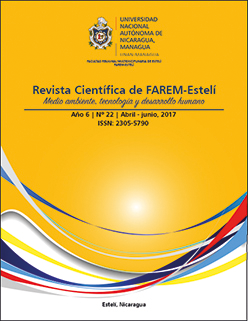A comparative study of soil macrofauna in agroforestry systems, traditional broadleaf forest and pasture in the dry tropical watershed, Tomabu; Nicaragua
DOI:
https://doi.org/10.5377/farem.v0i22.4520Keywords:
soil fauna, biodiversity, pitfall, macro invertebrates, NicaraguaAbstract
Disturbances caused by different changes such as the conversion from forest to pastures could modify the composition of the soil fauna and affect the probability of recovery of the original ecosystem. In Nicaragua there are few studies on the effects of this change of soil use on the edaphic communities. This study aims to identify and compare the soil macro fauna diversity in three systems of soil use: silvopastoral system, traditional pasture and broadleaf forest in a micro-watersheds of Central America dry tropics. The relation between macrofauna with the physicochemical characteristics of the soil conducted by statistical analysis of linear regressions. The study was carried out in the watershed Tomabú, which covers 3,676 hectares in the north of Nicaragua, Central America. The extraction of macrofauna of the soil as was obtained by the system of Berlesse-Tüllgreen and the use of pitfall. In the physicochemical analysis from soil, texture, organic matter, cation exchange capacity, nitrogen, phosphorus, potassium, calcium, magnesium, iron, copper, zinc, manganese, were determined. Diversity was determined by calculating the Shannon index. The results showed that the taxonomic richness found were 27 groups of arthropods identified at the level of order, with 9,880 collected individuals, among which hymenoptera, mites and isopteran are stand out. In the same way, the soils showed characteristics with similar numerical values in pH, organic matter, nitrogen, phosphorus and cation exchange capacity. It can be concluded that in Tomabú watershed there is a greatest diversity of soil macrofauna of forest system compare to the systems of livestock production of the study. However, there are no significant statistical differences when applying the analysis of ANDEVA, which is associated with soil pH and organic matter.
Downloads
1582
Downloads
Published
How to Cite
Issue
Section
License
© Revista Científica de FAREM-Estelí

